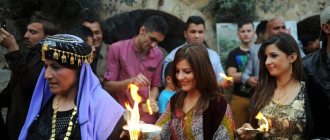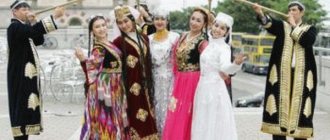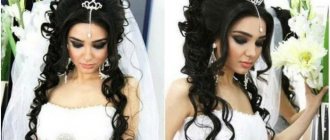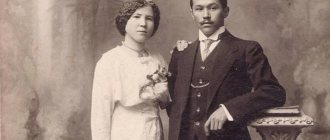Armenia is the first country in the world, back in 301, to adopt Christianity as the state religion. Since then, Armenian folk traditions and customs, many of which were pagan and developed over thousands of years, have been replenished with church Christian rites and rituals. And many of them intertwined with each other, acquiring a new color. The Church accepted and adjusted some of the pagan traditions. Today, residents of modern Armenia continue to sacredly honor most of the customs of their people, considering them an integral part of their culture and history.
Armenia is a country of traditions
This Transcaucasian country is located at the crossroads between West and East, Europe and Asia. It often found itself on the path of clashes between ancient mighty powers and great empires. The Armenian land has more than once turned into an arena of military operations. By remaining true to their traditions, language and culture, the Armenians were able to preserve their identity. In a word, it is the traditions and customs of the Armenian people that are the secret of their longevity. Sometimes they take on a certain artificial, demonstrative character, however, by returning to them again and again, the country’s residents respect their roots and preserve their identity.
Traditions are the main wealth of ancient peoples
Anthropologists, studying ancient nations, came to the conclusion that if representatives of a particular ethnic group deeply feel their roots, realize their involvement in this people, then over time they do not lose their customs and sacredly honor the traditions of their ancestors. So are the Armenians: they live, develop, adapt to new realities, but the Armenian traditions and customs, which were formed over many centuries and even millennia by their ancestors, remain unshakable. Moreover, representatives of this ancient nation consider them their national treasure and main wealth, and it does not matter to them whether these rituals are accompanied by joyful or sad events.
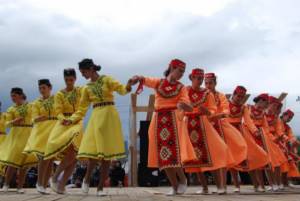
Holidays in Armenia
Armenian holidays are a whole kaleidoscope, where ancient customs are mixed with modernity, and pagan rituals with traditional beliefs. In my opinion, one of the most unusual and colorful holidays in Armenia is Vardavar. It is celebrated in the summer, at the height of the heat and drought.
On the holiday, Armenians love to pour water on each other, because Vardavar is dedicated to this very element. The roots of the holiday go back to ancient times. Then, a few weeks before Vardavar, the girls put wheat grains in the water. When they sprouted, the youth poured sacred water over each other, which was considered a symbol of longevity and life.
But at the end of winter, Armenians celebrate Trndez. It reminded me of a mixture of Russian Maslenitsa and Ivan Kupala Day. Why? Firstly, Trndez symbolizes the arrival of spring and the retreat of winter cold.
Secondly, its obligatory attribute is a fire that is lit in the church yard. Couples of lovers and newlyweds must jump over the flames to find happiness and strengthen their feelings. Armenians believe that jumping over a fire cleanses a person from all the bad things, all the sins that he might have committed.
A holiday dedicated to good deeds, love of God and helping poor people is Matah. On this day, church sacrifices are performed. People pray for forgiveness of sins, ask for mercy and offer their gifts to God. In Matakh, Armenians reflect on the past and future, honor the memory of deceased relatives, and honor the ancestors and founders of the clan.
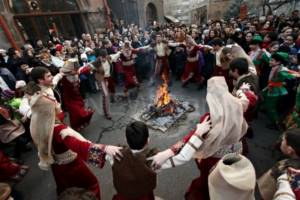
Armenian holiday Trndez
The traditions of the Armenians are the embodiment of the character and color of the population of Armenia. Like the famous Armenian wines, the customs of this people are full of bright accents and unusual combinations that make the culture even more interesting and richer. Despite all the difficulties that fate has faced the Armenians throughout history, these people managed to maintain their originality in their beliefs, traditions, and art. This is what makes many travelers who have visited Armenia once return there again and again.
Main Armenian traditions and customs
From time immemorial, for this ancient Christian people, marriage and family are considered the main national values, in which the husband remains the head, and the word of the eldest man in the clan is law for all its members. Respect for older people is also one of the fundamental traditions of the Armenian people. Family relationships are also cultivated in the country, and neighbors soon become closer to some relatives: they always help and support each other. Well, the biggest tradition in Armenia is hospitality. A person who has crossed the threshold of your home cannot be an unwanted guest. In Armenia, no one will understand the expression “an uninvited guest is worse than a Tatar.” For every family, it is a matter of honor to accept with dignity the people who come to their home and “respect their hearth.” The best place at the table belongs to the guest. And this is a tradition that is passed on from generation to generation.
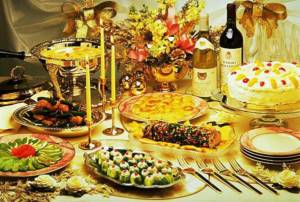
The influence of Western traditions on Armenian
Armenian families number up to 50 people. Thanks to the love between a man and a woman and mutual respect between generations, families remain friendly and strong for a long time.
The woman in the family plays the main role as the creator and keeper of the family hearth ; in the family there is an understanding of the importance of a man and respectful relationships between the younger and older in the family. Patriarchy reigns in Armenian families, which is based on love and respect for elders.
Western traditions had little influence on Armenian families. Women consider the family to be the main thing; they are the keepers of the hearth and a faithful support to their husband. They are subject to increased demands: you need to be a good housewife and look attractive, and take care of your appearance.
It has been noticed that recently bachelors from the West often come to Armenia to choose a faithful wife and create a happy, strong marriage.
Modification of family traditions
Later in the article we will tell you in more detail about the relationships between members of the same genus. In this small Transcaucasian mono-ethnic country, Armenian traditions and customs in the family continue to remain unchanged, despite the fact that the Armenians themselves believe that much has changed in their way of life, having received a Western “color”. For example, today most young families strive to live separately from their parents; women also take an active part in public life and have become more independent, which means that they are not able to devote themselves entirely to the family. In addition, today Armenian women do not want to get married early, are concerned with career issues, and can even give birth to a child out of wedlock in adulthood.
Origin of the people and language
Some historians consider the Phrygians to be the ancestors of modern Armenians. In any case, it was these people who began migrating from the territory of the Balkan Peninsula closer to the territories of Asia Minor in the middle of the first millennium BC. This mysterious, ancient ethnic group and the Armenians have something in common - or rather, language.
Origins of the Armenian language
According to researchers, the Phrygians were speakers of the Proto-Armenian language. They moved back in the 13th century BC to the Armenian Highlands and chose for themselves the northern region of present-day Armenia, which, both in ancient times and today, is known for its fertile lands. Thus, the Armenian language can be considered one of the most ancient in the world.
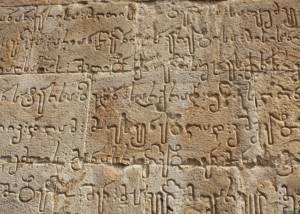
Amazingly, the Phrygians were able to retain the basic elements of their language, despite the fact that over time they were completely assimilated with the population that already lived here. In addition to them, the Luwians (a people related to the Hittites), Hurrians, as well as Urartians, who are considered the creators of one of the most powerful states in antiquity - Urartu, lived on the Armenian Highlands.
All these ethnic groups were able to coexist peacefully and over time formed the Armenian people. Therefore, speaking today about the Armenians, researchers consider them as representatives of a huge ethnic and cultural layer, because they are carriers of not only an ancient language, but also the genetic heirs of an entire era in the history of Asia Minor.
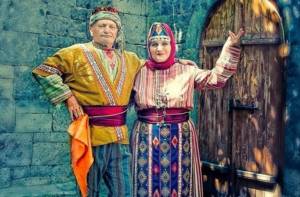
There are other versions - for example, some scientists see connections with other ethnic groups - Ido-Iranian and Greek. If you believe these historians, then the Armenian people were formed in the 22nd century BC and, thus, were the carriers of the Proto-Indo-European language, spreading it from the Armenian Highlands throughout the territory of all modern Europe and Near Asia.
No one can say with certainty how true this statement is. However, it is known that they, as an established national community, trace their history back over 2500 years. In the 7th century BC. they occupied vast territories not only of Transcaucasia, but of Asia Minor and the Middle East.
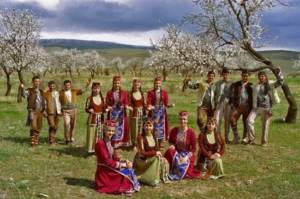
The history of the Armenians is confirmed both by ancient Greek sources, or more precisely, by the works of Xenophon and Herodotus, and by Babylonian ones.
Ancient history of the descendants of the Phrygians
In the 6th century BC. The state of Urartu collapsed, after which the territories of the Armenian Highlands fell under the rule of the Persian Achaemenid dynasty. In the 5th century before the rise of Christianity, the Armenians took part in the campaign of Xerxes, and a century later they recognized the power of Alexander the Great, although this conqueror was unable to conquer them. At the same time, they were already thinking about gaining independence, that is, about creating their own state.
By the 3rd century BC. the ethnic Armenian center shifted to the Ararat Valley, as a result of which in the middle of the 2nd century BC. the state of Greater Armenia was created, which was created by Artashes I. In subsequent centuries, they lost their independence several times and regained it again.
Their statehood at that time was still quite weak, so they had to survive among much stronger and warlike neighbors. Thus, in the middle of the 3rd century AD, the territories of the Armenians came under the rule of Persia, a century later they were divided by Iran and Rome.
In the 5th century they tried to regain independence against the Persians, but were defeated. However, as a result of serious political processes within the region itself, Persia was forced to admit that the status of their territories was only half dependent.
After this, the era of Byzantine rule began - by the way, it was during this period that the first deportation of Armenians was noted. More than 10 thousand people were sent to Cyprus. The Byzantine rulers, like the Persian ones earlier, repeatedly noted that the character of this people was quite rebellious, so they were prone to constant riots.
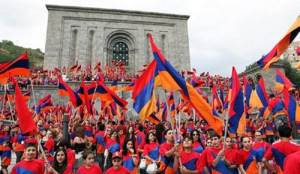
In the 7th century, Armenia was captured by the Arabs, after which many Armenians began to move to Byzantium, which they still considered more acceptable as a state power. In the second half of the 9th century, the famous Battle of the Forty took place, where they, united, managed to defeat thousands of Arab troops and, in fact, became independent.
Middle Ages and modern history
In the 14th century, Armenia began to experience serious political problems as new conquerors entered the world stage. This time Tamerlane was among them, and then the Ottoman Empire declared its claims to their territory. Here they had to deal with the impact not only on their statehood, but also on culture, and, more importantly, on religion.
By the 18th century, their national statehood was preserved only in the Nagorno-Karabakh region. However, they never intended to give up their independence, and periodic rebellions and national liberation movements arose, which were always brutally suppressed.
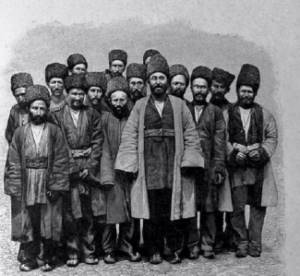
Finally, when Russia entered the political arena, the Armenians tried to make the most of this circumstance. At the beginning of the 19th century, the eastern territories of Armenia came under the rule of the Russian emperor. This was the reason for their mass migration here from other regions, primarily from the west of the country and from Iran.
Unfortunately, Russia made certain mistakes in its policy towards the Armenians, which led to a new liberation movement. They experienced pressure both from the royal authorities and from Turkey. The situation became even more complicated when, during World War I, the Ottoman Empire carried out the Armenian genocide, which remains one of the main sticking points between Armenia and Turkey today.
In 1915, the Turks began the physical extermination of the Armenian people living on their territory. As a result, thousands of people were tortured and killed. Historians still cannot come to a consensus on how many Armenians were destroyed during the genocide. Various figures are cited, ranging from 100 thousand to a million people.
The October Revolution in Russia brought changes to the Armenian population. Already in 1918, independent Armenia was proclaimed, and in 1920, Bolshevik rule was established in the territory. However, this was not without problems, the consequences of which we are still seeing. Thus, the Bolsheviks, outlining the borders of the Armenian Republic, assigned the region of Nagorno-Karabakh to Azerbaijan, but in this small territory, almost 95% of the population are ethnic Armenians.
Therefore, it is not surprising why the Armenians and Azerbaijanis subsequently repeatedly raised the issue of the territorial affiliation of Nagorno-Karabakh, which led in 1991 to the Karabakh armed conflict, which escalated into the Karabakh war, which dragged on for 4 years.
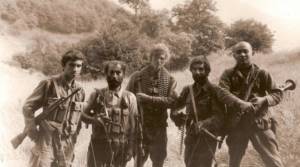
Armenia finally gained independence in 1991, when the Soviet Union collapsed. Since then, this country has been a full member of the community of Caucasian states and, nevertheless, maintains friendly relations with Russia, which cannot be said about some other former Soviet republics. As for the Armenian currency, it is the dram. Today the dram exchange rate against the dollar is on average 500:1.
Family traditions in modern Armenian society
Life changes, and nothing can remain steadfast. Nevertheless, there are Armenian customs and traditions that are relevant even in the modern Republic of Armenia. As before, the head of the family here is the husband, but if the family consists of several generations, then the eldest woman has broad rights, and she is accountable only to her husband, and her sons and their wives must obey her unquestioningly. Ideally, all this is done with love and respect, but there are many cases where young brides stand up to defend their rights in the family and, in order to avoid a serious conflict, their husbands are forced to separate from the parental home.
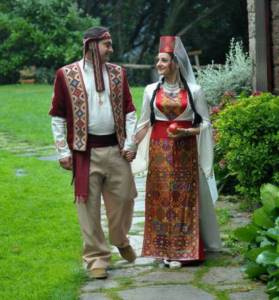
Armenian cuisine
Did you know that Armenian cuisine is one of the oldest in the world, which has preserved many recipes and traditions to this day. Distinctive features of the dishes:
- An abundance of herbs and spices.
- High salt content.
- Complex cooking process. Combining different cooking methods in one dish.
- Widespread use of meat. Unusual combination of ingredients.
- Preference for ghee over vegetable oil.
They also eat vegetables, legumes, and grains.
Return to contents
The place of a son-in-law in an Armenian home
Armenian family traditions and customs, as a rule, deny the possibility of a young family living with the wife’s parents, that is, with the mother-in-law and father-in-law. There is even a disparaging nickname - “house son-in-law”, which is given to young men who, after marriage, move to their spouse’s paternal home. However, this custom is often violated today, because sometimes city girls marry provincials who come from the regions, who, as a rule, do not have their own home. Naturally, the young wife does not want to go far away to the house of her husband’s parents, and the newlyweds remain to live in the wife’s house.
Funeral customs
Almost all peoples of the world have special rituals that add solemnity to the process of human burial. It is difficult to briefly describe all the customs and traditions of the Armenian people, especially when it concerns the saddest moments of our lives - saying goodbye to a loved one. At the same time, being Christians, Armenians observe all church rituals. That is, the deceased is buried either in church or in his home in the presence of all relatives and friends. At the same time, not only people who personally knew the deceased come to the funeral service, but also friends, acquaintances and colleagues of his family members.
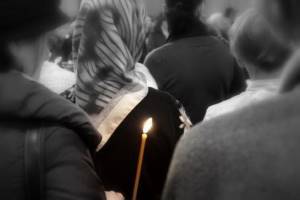
Marriage with an Armenian man/woman: pros and cons

Most likely, it is for this reason that men from this country are laconic. They prefer not to talk in vain, but to act.
Few people know that representatives of the stronger sex living on the territory of Armenia are only so strict and incredibly aggressive in appearance. Behind their beautiful appearance hide subtle and vulnerable natures who clearly know how to love, perform a lot of eccentric actions, are able to enjoy every moment, and are also ready to give their hearts to women.
But few people understand what marriage with an Armenian actually means? Of course, you need to pay attention that this is a strong family, which is built on mutual respect and understanding. Residents of this state know how to honor their own traditions and are also quite respectful of their elders.

Many women are interested in the question: where can you really meet an Armenian? Of course, you can go to this country as a tourist.
Few people know that this is truly a wonderful state. It is likely that you will be lucky enough to meet the man of your dreams, your real prince. If you can win his heart, you will become his legal wife.
Consequently, you will enter the Armenian family and also become its full member. After a certain time, you will realize how lucky you are. People who are the indigenous inhabitants of this amazing country put family above all else.
For this reason, they strive to create not only incredibly strong, but also quite large families. An Armenian man, naturally, is always the head of the family. But, it should be noted that this is not a despot or a tyrant. He is first and foremost a caring and loving husband, as well as a father.
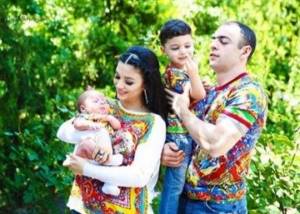
Such a responsible and strong-willed representative of the stronger sex will work tirelessly to provide for his own wife and children.
Armenians love children very much, they spoil them . Kids always live in care, honesty, loyalty and respect. But an integral part of education is discipline, as well as rigor.
If you accept all the laws, traditions and customs of a given people, then your acquaintance with an Armenian can develop into something more. If love doesn't work out, you are definitely guaranteed friendship. But how can we understand their holy traditions?
First of all, you need to become more familiar with the history of Armenia. You should feel all the pain of the Armenian people.
It should be noted that in temperament and character, Armenians are very different from the peoples of the Caucasus.
They are more reasonable, full of confidence and dignity. Another distinctive quality of such men is calmness.
The wars that were fought on the territory of their state for quite a long time taught them to value kindness, peace, and also to live in harmony with their neighbors and at the same time enjoy life.
Funeral ceremony
On the day of the funeral, a priest is invited, who again performs the funeral service for the deceased and, together with the funeral procession, goes to the cemetery. There are areas in Armenia where women are not allowed to go to the graveyard on the day of the funeral. Upon returning home, the funeral participants will find a rich meal. People eat and, without clinking glasses, drink for the repose of the soul of the deceased. The next day, a group of close people gathers in the house and again goes to the cemetery, and then gathers at a set table, again remembering the deceased. Funeral ceremonies are also held on the seventh and fortieth days and on the anniversary of the sad event, as well as on church holidays: Christmas, Easter, the Feast of the Holy Cross, etc. For 40 days, men (close relatives of the deceased) do not shave their beards, and women are in mourning.
The lid of the coffin or how Armenians prepare the deceased for funeral
The news of death quickly spreads among relatives, friends and neighbors, and everyone rushes to the house of the deceased to express their condolences to his family and wish him a bright afterlife. According to tradition, it is customary to place a coffin lid at the door to an apartment or entrance to inform about a mourning event, and also to ask those passing by to behave according to the occasion and refrain from fun and loud conversations.
In general, the funeral rites among Armenians correspond to Christian canons and do not differ much from the customs widespread in Russia. Nowadays, most of the preparatory procedures are performed in appropriate medical institutions, but ablution traditionally takes place at home. A priest is invited to the house, who reads a prayer over the deceased and blesses the water for ablution. Bathers place the deceased on a special table or bench facing east and wash his body with blessed water and soap, starting from the head and ending with the feet. If after this procedure there is liquid left in the vessel, it is poured over the hands and feet of the bathers in order to “wash away” the touch of death from them. Then the dishes containing the water are broken and the shards are thrown away.
Armenian wedding: traditions and customs
Before we talk about how a traditional wedding ceremony takes place in Armenia, I would like to describe the details of the matchmaking process. Well, first of all, let's start with the fact that half a century ago Armenia was more traditional in this matter. There were times when brides and grooms saw each other only on the day of matchmaking or even engagement. That is, they got married and got married “blindly.” Nowadays this is rare even in the most remote village. Today, girls and boys first meet, fall in love, date, then meet each other's parents, then traditional matchmaking, betrothal and, finally, wedding take place. And all this is a tribute to the national, although today only the name remains of these traditions. And all these events are so modified that it is difficult to discern even echoes of the past in them.

Woman and her place in Armenian society
In modern Armenia, despite all the changes, Armenian customs and traditions for girls are much more strict than for men. For example, it is not appropriate for representatives of the fair sex to meet guys on the street. This is exactly what mothers teach their daughters almost from childhood. However, today young people manage to meet each other through social networks, communicate online, and after some time the guys ask their crush to meet.
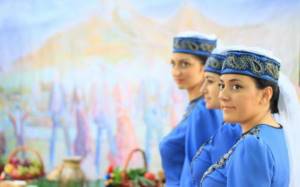
According to modern Armenian tradition, a girl should not immediately agree to the gentleman’s persuasion; she should “test” his feelings by delaying the time of the meeting. If a girl has a brother, especially an older one, then a guy who has designs on his sister should definitely meet him and ask for his permission. In short, secret meetings are not approved in Armenia. After several dates, if the young people decide to start a serious relationship, the parents agree on matchmaking or immediately an engagement: sometimes one smoothly develops into the other.
Matchmaking
Surely many are interested in how an Armenian wedding takes place. Traditions and customs in modern society have largely lost their relevance, although there are families who advocate the revival of the national and in every possible way strive to adhere to the rules and canons that were created thousands of years ago. So, the first step in this process is matchmaking. In the old days, when people lived in small towns and villages and everyone knew each other, this process was entrusted to an intermediary - a mutual friend of two families. However, today this stage has completely dropped out of the series of pre-wedding events. It is not customary to go to matchmaking in a large group. The matchmaking team includes the groom's mother, father, grandparents, and older brother or sister. They take with them sweets, Armenian cognac, a bouquet of flowers and a gold ring for the bride (but not a wedding ring). The girl's parents greet them with restraint. There should be no treats on the table. Negotiations continue for some time, the parties get to know each other. The outcome of this conversation may be the most unexpected: either the father of the bride will agree to give his daughter to this guy, or not. In the first case, a girl is invited to the “negotiation” room, and her father asks her if she agrees to marry this young man. The girl, as a rule, responds with a slight nod - either denial or agreement. In the first case, the groom approaches her and puts a ring on the ring finger of her left hand, then glasses are brought to the table and two bottles of cognac are uncorked. A little from each bottle is poured into each glass. First the fathers clink glasses, and then everyone else. This is followed by a treat. In case of refusal, the matchmakers leave without even seeing the girl and without asking her consent.
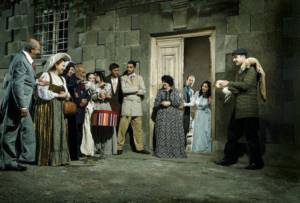
Family Traditions of Armenians – Historical Sketch
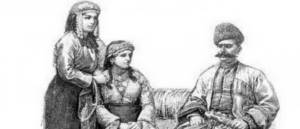
Traditional Armenian life, as well as the life of many other peoples of the world, was characterized by large patriarchal family communities - gerdastan, uniting up to 50 or more relatives of several generations, with clearly defined gender and age regulation of the rights and responsibilities of their members.
It is not for nothing that the word yntanik (“family” in Armenian) means “under the roof”, i.e. This means living together in the same house, under the same roof. At the same time, people more often used the words ojakh (hearth), mets ojakh (big hearth), tsukh (smoke), tun (house) or, as they said in Artsakh, mets ton (big house) to denote family.
In large family communities, parents and adult sons lived together, who in turn had children and even grandchildren. At the head of such a community was the eldest man in the house, who enjoyed unlimited power - the tanter, the owner of the house, who alone controlled both the movable and immovable property of the gerdastan, and the personal destinies of its members.
The unlimited power of his power is characterized by everyday writers of the past with such eloquent words as “arbitrary ruler”, “despot”, “sovereign”, etc.
The functions of the tanter included the organization of the family economy, the management of men's household work, mainly agricultural and cattle breeding, and control over all family income, including the earnings of its individual members.
At the same time, despite the clearly despotic nature of his power, when deciding the most important issues, he consulted with older family members, especially with his brothers if they lived with him. In the second half of the 19th century. In Armenia, there were families (though as a rare exception, notes E.T. Karapetyan), in which the power of the father was controlled by the council of elders or family “meetings.”
In relation to the head of the family, certain norms of etiquette were adopted: when he appeared, everyone stood up, his instructions were listened to while standing, it was forbidden to talk loudly or smoke in his presence; The tanter was the first to sit down at the table, occupying a central place by the fireplace, and the first to go to bed, and the youngest daughter-in-law had to take off his shoes, undress him, wash his feet and put him to bed. All family members, regardless of gender and age, obeyed him unquestioningly.
The only exception was the eldest woman in the house, who enjoyed great authority in the family - tantirui or tantikin, the mistress or mistress of the house. Usually this was the wife of the head of the family, but if she died before her husband, then her rights passed to the wife of the next most senior man - an older brother or son. In this case, her authority was recognized by all relatives and was higher than the authority of her husband, who, while his older brother or father was alive, remained a subordinate member of the family.
Tachtikin supervised all women's work in the family - housekeeping, processing of agricultural products and livestock raw materials, baked bread herself, cooked lunch, distributed it among family members, and monitored cleanliness and order.
She was in charge of all the material assets of the house and the keys to it, food; no one could take anything without her permission. In her immediate competence, as Elalayan put it, “there was the helm of the family.” Tanter, having crossed the threshold of the house, himself obeyed the order established by her in everything.
It is not for nothing that a popular proverb says: The husband is the outer wall of the house, and the wife is the inner wall. The opinion of the Tantikin was decisive when choosing a wife for his son; matchmakers turned to her first when it came to the marriage of her daughter. Only the tanticin could turn to the tanter on all household issues and was the only woman in the family who had the right to sit at the table with the men.
Nevertheless, the range of daily responsibilities of Armenian women in a large family was very wide. So, Elalayan wrote about this: the eldest daughter-in-law makes dough, milks the cattle, spins wool, goes to a high-mountain pasture in the summer and prepares cheese and butter there; the second and third daughters-in-law sift flour, light toner, weave various woolen products and carpets, sew, darn, take food to men working in the fields, work on the threshing floor; the youngest daughter-in-law goes to fetch water every morning, dresses her father-in-law and mother-in-law, gives everyone water for washing, makes and removes the beds, sweeps, lights the fire, gives everyone shoes, opens the door, brings dinner, clears the table.
She takes off everyone's shoes, including her husband, puts her father-in-law and mother-in-law to bed, and herself goes to bed later than everyone else and gets up earlier than everyone else. Unmarried daughters were freer. As needed, they helped their daughters-in-law with housework, but were mainly busy with needlework and preparing a dowry.
The relationships between members of a traditional Armenian family were largely regulated by one of the archaic customs widespread in the world - the custom of avoidance. Among different peoples, ethnographers have noted four main groups of avoidance depending on the category of persons between whom they arose: prohibitions in relations between the spouses themselves; between parents and children; between a woman and her husband's relatives; between a man and his wife's relatives.
These same forms of avoidance were also characteristic of Armenians, but they persisted to varying degrees. Thus, materials from the 19th century. show that a man’s avoidance of his wife’s relatives was by this time of a purely relict nature, manifesting itself only in some wedding rituals, but not in everyday life. For the longest time, Armenians maintained a woman's avoidance of her husband's relatives (mostly older ones), which was explained by the patriarchal nature of the Armenian family and the position of women in it.
This custom was popularly called chkhoskanutyun or ankhosk (literally “taciturnity”), another name is harsnutyun (from hars - “daughter-in-law”).
In the traditional Armenian family, the ban was firmly maintained even on pronouncing the name of the wife or husband; for spouses it was considered a “special shame” to call each other by name, to say “my husband”, “my wife”. These words were replaced by others, for example, the husband called his wife akhchi ("girl"), the husband's wife - mard ("man"), and in the presence of strangers - "son" or "brother" or, respectively, "daughter" or "sister" of such a person. That.
If a husband needed to convey something to his wife, he usually addressed her through his mother, saying; “Tell her that...” When addressing her mother-in-law, the daughter-in-law, without mentioning her husband’s name, said: “Your son,” and in a conversation with her mother or father, “your son-in-law.” Avoidance in the relationship between parents and children in the Armenian family affected the father to a greater extent than the mother.
The father, in the presence of his older relatives or even strangers, should not have picked up the child, played with him, etc. The parents tried not to show that this child belonged to them. If they were asked whose child it was, they answered, “I’m ashamed to say, ours,” and then avoided saying “mine.”
There are many reports in the literature about Armenian women avoiding their husband’s older relatives. So, even the Armenian historian of the 5th century. Favtos Buzand wrote that Tirit, Gnel’s cousin (both were nephews of King Arshak II), having heard about the remarkable beauty of the latter’s wife, Parandzem, “... was looking for an opportunity... to see his daughter-in-law,” which indicates that in the past an Armenian woman was not entitled even appear in front of your spouse's relatives.
According to A. Haxthauzen, a married Armenian woman “should not talk to anyone... she talks to her husband - and only when she is alone with him: with everyone else she communicates only with gestures.”
As it was reported in the 80s of the 19th century, among the rural Armenian population, a young woman “after a year is obliged to walk only with her face covered, and until the first birth she has no right to speak with either her husband’s parents or the eldest of her closest relatives. During all this time, if necessary, she is allowed to communicate with them only through translators: the role of the latter is played by small children.”
According to Kh. Samuelyan, “the daughter-in-law in the family does not have the right to speak with any of her husband’s relatives (except for children) and even with her husband in the presence of strangers.
Before the birth of her first child, in some places even for seven years from the date of marriage, she appears with her face covered and speaks to everyone with facial expressions. The daughter-in-law should not speak with her father-in-law until her death, with her mother-in-law until she is pregnant with her first child, and with her brothers-in-law for 10-15 years.
Outside the family, every woman not only does not have the right to speak with her imprisoned father, the Cavor, but it is even considered a great sin to appear in front of him. Young daughters-in-law are also obliged, to show honor to the elderly, neighbors, and companions of their father-in-law, not to speak to them for 5-6 years.”
S. D. Lisitsian wrote that “the daughter-in-law was not allowed to speak to the “elder” (i.e., mother-in-law) except by signs. A special manner of speaking with the help of signs developed, which daughters-in-law used when addressing older men, especially their father-in-law and older brothers-in-law.” Similar descriptions of this custom are available in other publications.
Property and legal relations of members of the family community were based on family collective property, with elements of personal property, which consisted of items of personal use, primarily clothing and weapons, as well as jewelry.
The woman's personal property included her dowry, consisting of property allocated from the general family property of her father's house. It increased due to the woman’s work in her husband’s family and gifts received from the groom’s relatives during the bride and wedding, as well as after the birth of children, especially the firstborn.
The father's house went to the eldest or youngest of the brothers. For the remaining brothers, houses were built using common funds or appropriate property was allocated taking into account construction costs.
If the mother, who was considered the keeper of the family hearth, was alive, then she, along with her unmarried daughters, remained, as a rule, in the family of the youngest son, and in this case the father’s house went to him. If the mother was not alive, then the eldest son remained in this house, as the main heir worthy of taking the place of his father.
Armenians, like other peoples of the Caucasus, have always been characterized by close family ties. Blood relatives were part of one large related patronymic group - azg (the term in the Armenian language has multiple meanings: “people”, “nation”, “group of relatives”, etc.).
Azg was formed by dividing the expanded family community into small and large subsidiary families, which, having become independent, continued to maintain certain economic, territorial and spiritual ties.
Over time, these families, growing, broke up again, and as a result of such consistent segmentation, a collective of related families was formed, numbering up to seven or eight generations, descending from one common ancestor and interconnected mainly by spiritual interests.
Patronymic ties were largely supplemented by neighborhood-community ties and, with the localized settlement of families of the same patronymic, were closely intertwined with them. These connections took the form of mutual assistance and influenced the formation of public opinion.
Among the Armenians, relatives on the paternal and maternal lines were called differently: azgakan (lit. “relative”) and barekam (lit. “well-wisher”), respectively. The mother's brother, Kerry, was considered a particularly close relative.
In traditional life, strict adherence to the custom of hospitality, widespread in the Caucasus, was mandatory for Armenians. “A guest from God,” the people said, and therefore, shelter and food were always ready for every traveler who knocked on the house, and oats and water were always ready for his horse.
At the same time, it was considered decent, if necessary, to ask a neighbor for bed or food for a guest, since the guest was considered to be in common. Guests who arrived from afar were treated with special honor.
According to etiquette, such a guest was supposed to be the center of attention of the family and not be left alone. They sat him in a place of honor, talked to him, invited relatives and neighbors for him, entertained him, gave him gifts and tried in every possible way to please him.
In Western Armenian villages, a special room was usually kept for guests and officials who came on official business, where a servant was appointed and food was sent to the guests one by one. This was caused by the reluctance to receive Turkish officials in their home, since they could behave extremely intrusively, making demands offensive to the honor of the family.
Gerdastans in Armenia were distinguished by relatively high stability and were found at the end of the 19th century. and sometimes even at the beginning of the 20th century. Numerous (up to 100 people or more) family communities, consisting of five or six generations of relatives, with their patriarchal life based on subsistence farming, persisted at the end of the last century in some remote villages of the mountainous regions of Western Armenia (the villages of Sasun, Dersim).
But in general, large-family communities were no longer characteristic of Armenian society. Their collapse was due to changing socio-economic conditions, the development of capitalism, commodity-money relations, and the strengthening of private property tendencies.
This was especially noticeable where otkhodnichestvo developed, which contributed to the disintegration of family property, subsistence farming and the patriarchal way of life of the family, as happened, for example, according to the testimony of S. D. Lisitsian, in Artsakh.
Acquaintance with the life of workers of other nationalities undoubtedly had a certain impact on the traditional life of the Armenians, and the economic factor played a decisive role in this: having earned money, an adult married son preferred to separate with his wife and children, rather than give this money to the general family treasury, as is the case has always been customary in large families.
By the end of the 19th century, families that united parents with married sons and their young children became typical for Armenia; sons with adult children formed an independent family. Thus, the process of reducing the average number of families gradually began.
For example, in the 80s of the XIX century. the average size of an Armenian family ranged from 6.0 to 9.6 people in a number of valley villages, and from 8.2 to 14.3 people in mountain villages; at the end of the 19th century in the Kars and Yerevan provinces populated mainly by Armenians, the average size of the household was 7.6 people (including 7.9 in cities, 7.6 in villages) and 7.1 people (6.1 and 7.3), respectively. Armenian families in Tbilisi were comparatively smaller in size. The vast majority of them united from 2 to 5 people and about a quarter - from 6 to 10 people. hayadat.ru
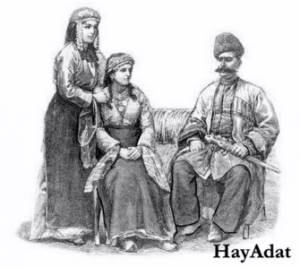
Engagement
Armenian wedding traditions and customs are very interesting. After matchmaking comes the betrothal ceremony. The main organizer of this event is the bride's side. The girl’s family sets the tables (today this is done in a restaurant), and relatives are invited. The groom's side prepares baskets with gifts. Each of the invited women comes with her own gift, placed in a basket with fruits, sweets and drinks. Naturally, bouquets, a cake, and, of course, an engagement ring are prepared for the bride.

This time the cortege is greeted with open arms and smiles, because the groom’s relatives are welcome guests, future relatives. Then the actual betrothal ceremony takes place. Ideally, everything should happen in the church, but this is rarely adhered to today. The newlyweds simply put rings on each other, and the parents uncork the cognacs. Then comes a real feast and dancing, dancing, dancing...
Wedding
If you want to see what real Armenian traditions and customs are like (photos from some events are in the article), then it’s better to go somewhere in the provinces. In the city, especially in the capital, young people gravitate towards everything foreign, and an Armenian wedding turns into a real mix of traditionally Armenian, European, and sometimes, no matter how absurd it may sound, Arab.
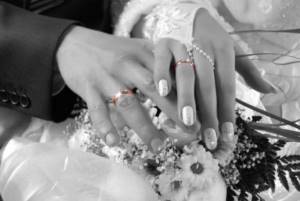
In the bride's house: wedding dress ceremony
Gifts for the bride (sometimes a dress) and several attributes are placed in the basket: shoes (required), veil, perfume, cosmetics, handbag, bouquet, etc. According to ancient custom, after the arrival of the matchmakers, all the women gathered in the girl’s room and dressed the bride, singing ritual songs. The young woman had to dress up in everything new bought by the groom. In the process, one of her shoes disappeared somewhere, and it was supposed to be “stolen” by one of the bride’s relatives. Kavorkin must pay a ransom to return the shoe. The veil is put on by twisting it three times around the bride’s head. Then the groom is invited into the room, and he, lifting the veil from the bride’s face, kisses her and leads her out to the guests. However, another obstacle awaits them here. The bride's brother with a sword in his hands blocks their way and also demands a ransom. This time the groom has to fork out the cash.
Wedding
After a small feast in the bride's house, the newlyweds and the wedding cortege go to the church, where the wedding ceremony takes place. After this, the newlyweds go to the groom’s house, where they are met with pita bread and honey by the groom’s mother. She throws pita bread on the shoulders of the bride and groom and gives them a spoonful of honey.
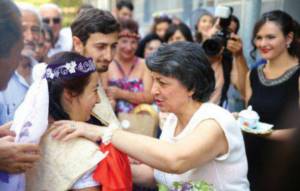
This is a sign that they live in peace and harmony. The newlywed must then break the plate with her heel before entering her new husband's house. After this, a long feast begins, during which the bride is presented with gold gifts. The last stage is the bride’s dance, after which the newlyweds leave the hall, but the wedding continues.
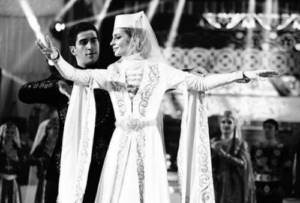
How does matchmaking and engagement work?
Among Armenians, the right to choose a bride belongs to the groom’s parents, or more precisely, to his mother. The woman is very enthusiastic about finding a suitable match for her son, taking into account not only the girl’s background, but also her health, hard work and education. There are no special requirements for external evaluation criteria.
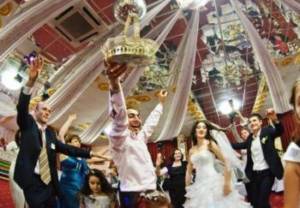
Next, the groom’s mother negotiated her choice with her husband, after which a mediator was selected among close relatives. Her goal was to negotiate over the young man's intentions to marry the girl. If a positive response was received from the bride's mother, the matchmaking could take place.
The Armenian wedding ceremony begins with matchmaking, which is attended exclusively by men. They discuss the purpose of their visit with the bride’s relatives and ask for approval for their children’s marriage. But according to tradition, the first time a positive answer from the girl’s parents could not be given. This meant that a second visit could not be avoided.
After successful matchmaking comes an equally important part of preparing for the wedding - engagement.
The expected engagement day is agreed upon in advance. Many relatives gather at the groom's house, bringing with them various gifts for the young bride.
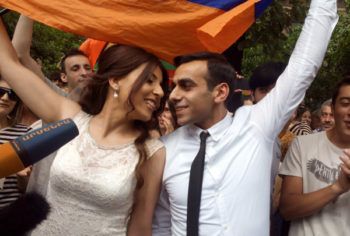
First, the feast is held at the groom's place, and a rich festive table is laid out. Later, the same event takes place in the bride’s house, with the same characters.
A respected relative (kavor) from the groom’s side takes the bride and her bridesmaids out and places them at the groom’s table. A young girl accepts gifts from guests. After this, the newly minted groom puts a wedding ring on his beloved’s finger. The engagement is accompanied by songs, dances and fun competitions.
After the entertainment part of the holiday has come to an end, the kavor and the groom's father decide on what day the wedding celebration will take place.



